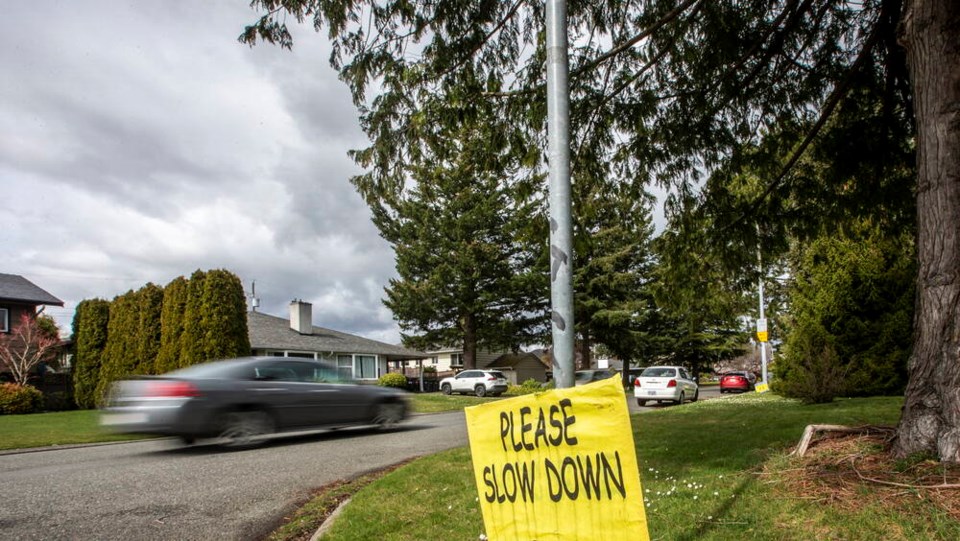With a goal of establishing a default speed limit of 30 km/h on neighbourhood roads, the City of Victoria has told staff to prepare changes to its streets and traffic bylaw.
Noting that other municipalities in the region, such as Saanich and Esquimalt, have been moving in this direction, as have parts of Toronto, Montreal, Vancouver, Victoria intends to roll out the lower speed limit over several years.
A city staff report said when the new bylaw is adopted, Victoria would implement new signage based on factors such as collision history, the presence of vulnerable populations, parks, schools, care facilities and community centres.
Municipal councils have the authority to set speed limits on roads under their jurisdiction.
Victoria’s project would focus on residential streets. It would exclude arterial streets such as Bay, Blanshard, Cook and Douglas or secondary arterial streets such as parts of Dallas Road, Finlayson Street, Government Street and Fort Street or collector streets such as Belleville Street, Caledonia Avenue, Foul Bay Road and Menzies Street.
Victoria council was split on an initiative that would reduce the default speed to 30 km/h on many roads in the city from the current default of 50 km/h for urban roads, set by the province.
Some councillors felt the exercise would be pointless.
Coun. Geoff Young said he has been on record supporting the reduction of the speed limit, but 30 km/h is too much.
“I think we’re going too far with this,” he said. “I was supportive of the 40 km/h limit.”
With little enforcement other than signage imploring drivers to slow to 30 km/h, the move is “an empty gesture,” Young said.
“I think we are taking a step that is too far and that, by doing so, we are going to set this process of reducing local speeds backwards,” he said.
“I think by adopting a more modest goal and one that I believe our neighbour [municipalities] were prepared to subscribe to earlier at 40 km/h, we had a good chance of even achieving provincial buy-in to some kind of default local limit.”
Mayor Lisa Helps said it would be an empty gesture if Victoria was all alone in making the change and only put up signs.
But the indications are surrounding municipalities are on-side and, combined with traffic-calming measures, the signs might have an effect, she said.
“It’s good to see our colleagues in other municipalities and their staff working hard to achieve Vision Zero,” she said. “This is really about livability and public safety.”
Vision Zero, created in Europe in the 1990s, is aimed at reducing fatalities through better road design, speed reduction and other measures.
Ross Kenny, the city’s assistant director of transportation, said the public supports speed-limit reduction.
“As recently as two weeks ago, a poll of B.C. residents found that two thirds of residents in B.C. supported a reduction in speed limits on local roads to 30 km/h. On Vancouver Island, there was nearly 60 per cent support for this reduction,” he said.
“Recent dialogue through the CRD transportation working group has also enabled staff to confirm other communities in the region remain supportive in delivering speed limit reductions on their local roads.”
Coun. Stephen Andrew, who along with Young and Charlayne Thornton-Joe voted against the initiative, said if the speed limit is cut, there has to be education and proper signage.
“I don’t want to set people up for failure, I hope they know where we’re going, that they know what the signs are and they follow the speed limits,” Andrew said.
Coun. Ben Isitt, who supported the project, said encouraging drivers to reduce speed is about safety
“I’ve come around to the view that we can’t compromise on safety and that Vision Zero is the appropriate policy for the city,” he said.
“If we’re going to err, I would strongly prefer to err on the side of safety.”
The city’s staff report said slower speeds contribute to improved comfort for pedestrians and cyclists, and less noise.
“When they do occur, collisions with vulnerable road users at 30 km/h or less correlate with a 10 per cent probability of death when compared with a 30 per cent probability of death at 40 km/h or 85 per cent at 50 km/h,” the report said.
>>> To comment on this article, write a letter to the editor: [email protected]



